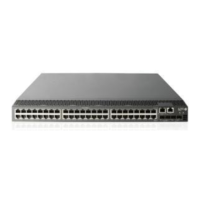49
Ste
Command
Remarks
6. Specify the HTTPS service
port number.
ip https port port-number
Optional.
The default HTTPS service port is 443.
7. Associate the HTTPS
service with an ACL.
ip https acl acl-number
By default, the HTTPS service is not
associated with any ACL.
Associating the HTTPS service with an
ACL enables the device to allow only
clients permitted by the ACL to access
the device.
8. Specify the authentication
mode for users trying to
log in to the device
through HTTPS.
web https-authorization mode
{ auto | manual }
Optional.
By default, a user must enter the correct
username and password to log in
through HTTPS.
When the auto mode is enabled:
• If the user's PKI certificate is correct
and not expired, the CN field in the
certificate is used as the username to
perform AAA authentication. If the
authentication succeeds, the user
automatically enters the Web
interface of the device.
• If the user's PKI certificate is correct
and not expired, but the AAA
authentication fails, the device shows
the Web login page. The user can
log in to the device after entering
correct username and password.
9. Set the Web user
connection timeout time.
web idle-timeout minutes
Optional.
By default, the Web connection timeout
time is 10 minutes.
10. Set the size of the buffer
for Web login logging.
web logbuffer size pieces
Optional.
By default, the buffer can store up to 512
logs.
11. Create a local user and
enter local user view.
local-user user-name By default, no local user is configured.
12. Configure a password for
the local user.
• In non-FIPS mode:
password [ [ hash ] { cipher |
simple } password ]
• In FIPS mode:
password
By default, no password is configured
for the local user.
13. Specify the command
level of the local user.
authorization-attribute level level
By default, no command level is
configured for the local user.
14. Specify the Web service
type for the local user.
service-type web
By default, no service type is configured
for the local user.
15. Exit to system view.
quit N/A

